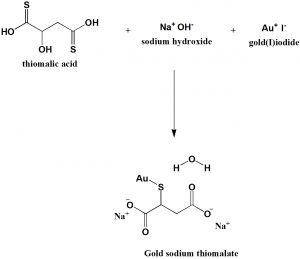SODIUM AUROTHIOMALATE Synthesis, SAR, MCQ,Structure,Chemical Properties and Therapeutic Uses
Gold Sodium Thiomalate
Or
Sodium Aurothiomalate
IUPAC nomenclature
Disodium;gold(1+);2-sulfidobutanedioate;hydrate
Classification
- Synthetic Disease-Modifying Ant rheumatic Drugs (DMARDs)
- Gold compounds
Physiochemical Properties
| S. NO. | PHYSICAL AND CHEMICAL PROPERTIES | |
| 1 | Molecular weight | 408.09 g/mol |
| 2 | Physical appearance | Mixture of mono- and disodium salts; white to yellowish-white powder |
| 3 | Melting point | 100oC |
| 4 | Solubility | Very soluble in water and insoluble in alcohol |
| 5 | Octanol/water partition coefficient | N/A |
| 6 | Presence of ring | Not present |
| 7 | Number of chiral centers | Not present |
Mechanism of Action
- Gold sodium thiomalate inhibits prostaglandins synthesis
- There is a suppressive effect on the synovitis of active rheumatoid disease by the drug.
Structure Activity Relationship
General SAR for Gold compounds can be summarized as follows:
- Monovalent gold is more active than trivalent or colloidal gold.
- Attachment of the gold with the sulfur containing ligand is essential for the activity of the drug.
- Complexation of the gold ions with phosphine increases the bioavailability.
- Injectible gold compounds should be monocoordinated.
- Triethylphosphine gold compounds show the highest activity. [1]
Method of synthesis
i. Thiomalic acid is mixed with the aqueous suspension of gold(I)iodide.
ii. The resultant mono- and disodium salts are precipitated by the addition of ethanol.[2]
Therapeutic Uses
Gold sodium thiomalate is used for:
- Treatment of patients having rheumatoid arthritis who did not respond to or cannot take other medication for the disease.
Side Effects
Side effects of Gold sodium thiomalate are:
- Dizziness
- Drowsiness
- Flushing
- Headache
- Vomiting
- Weakness
- Sweating
- Eye pain
- Eye redness
- Fainting
- Loss of hair
- Mood changes
- Confusion
- Hallucinations
- Seizures
- Stomatitis
- Painful breathing
- Low blood count signs
- Pale skin color
- Cough
- Diarrhea
- Grayish or bluish skin color
- Abdominal pain
- Urine color changes
- Vaginal sores
- Allergic reactions
- Rash
MCQs
Q.1 Which statements are correct with respect to the physicochemical properties of drug gold sodium thiomalate?
I. Molecular weight:408.09gm/mol
II. Appearance: Yellow white crystalline solid
III. Melting point: 153oC
a) I, II
b) II, III
c) I, II, III
d) I, III
Q.2 Match the following of the drugs with their correct IUPAC names.
| i. Gold sodium thiomalate | A. ethyl 1-(3-cyano-3,3-diphenylpropyl)-4-phenylpiperidine-4-carboxylate |
| ii. Diclofenac | B. (5α,6α)-7,8-didehydro-4,5-epoxy-3-methoxy-17-methylmorphinan-6-ol |
| iii. Diphenoxylate | C. Disodium;gold(1+);2-sulfidobutanedioate;hydrate |
| iv. Codeine | D. [2-(2,6-Dichloroanilino)phenyl]acetic acid |
a) i-C, ii-D, iii-A, iv-B
b) i-D, ii-B, iii-A, iv-C
c) i-C, ii-A, iii-D, iv-B
d) i-B, ii-C, iii-D, iv-A
Q.3 Mechanism of action of Gold sodium thiomalate includes?
I. Inhibition of prostaglandin synthesis
II. Inhibition of acetylcholine synthesis
III. Suppressive effect on synovitis of active rheumatoid disease
IV. Alkylation of genetic material
a) II, IV
b) I, II, III
c) I, III
d) II, III, IV
Q.4 Correct sequence for True/false for the classification of the drug can be?
- Gold sodium thiomalate: DMARDs
- Prednisolone: Antineoplastic drugs
- Anastrozole: NSAID
- CCNU: Triazine alkylating agent
a) TFFT
b) FTFT
c) FFTF
d) TTFF
Q.5 In the gold compound DMARDs, attachment of the gold with sulfur?
a) Decreases the activity
b) Increases the activity
c) Is essential for the activity
d) Has no impact on the activity of drug
Q.6 Type of ring present in the structure of Sodium aurothiomalate?
I. Oxazolidine
II. Naphthaline
III. Phenyl
IV. Furan
a) I, III
b) II, IV
c) I, III, IV
d) No ring structure present
Q.7 Side effect of drug Gold sodium thiomalate?
a) Seizures
b) Eye redness
c) Stomatitis
d) All of the above
Participate in Online FREE GPAT TEST: CLICK HERE
Participate in Online FREE Pharmacist TEST: CLICK HERE
Participate in Online FREE Drug Inspector TEST: CLICK HERE
ANSWERS
1-a
2-a
3-c
4-d
5-c
6-d
7-d

